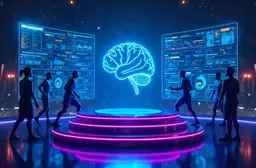Machine Learning in Sports Revolution Performance & Strategy

Table of Contents
Today, the lines between traditional athleticism and technological intelligence are blurring fast. Machine learning in sports isn’t just a futuristic concept—it’s already transforming how teams train, strategize, and win. From real-time sports analytics to automated coaching, AI is rewriting the playbook of competitive sports.
As we step into this fascinating intersection of sports and data science, we can’t help but wonder: Are we witnessing the end of gut-driven decisions in athletics—and the rise of data-dominated victory? Let’s explore how machine learning is redefining every aspect of sports, from athlete performance prediction to intelligent coaching systems.
Understanding Machine Learning in Sports
Machine learning (ML) is a subset of artificial intelligence (AI) that enables systems to learn and improve from data without being explicitly programmed. In sports, this translates to the ability to analyze vast amounts of information—from player stats to motion data—and draw meaningful, predictive insights.
Machine learning in sports enables more precise decisions, better game outcomes, and long-term performance optimization. Coaches, analysts, and athletes are embracing sports data science to gain competitive advantages that were previously unimaginable.
Take, for instance, the use of computer vision for sports. Cameras and sensors capture players’ movements, feeding neural networks that detect patterns and flag risks—such as fatigue or inefficient biomechanics. These AI-powered insights not only help in injury prevention but also drive performance improvements.
Enhancing Athlete Performance Through Deep Learning

Athlete performance isn’t just about talent anymore—it’s about data. Deep learning in sports performance delves deeper into muscle activity, hydration levels, and sleep patterns, all measured through wearable tech and processed through sophisticated algorithms.
With this data, we can:
- Personalize training programs to match an athlete’s specific physiology
- Predict injuries before they happen using anomaly detection in data streams
- Optimize recovery by identifying peak rest periods and adjusting schedules accordingly
A notable case is the NBA’s use of AI-powered sports technology to monitor players’ load and avoid overtraining. “Data doesn’t just describe performance; it predicts it,” said a sports scientist at a leading NBA franchise.
Statistical sports analysis through ML also allows coaches to test various scenarios before the game. For example, should a player take a three-pointer from the left wing under pressure? ML models can simulate the likelihood of success using historical performance and real-time factors.
Strategic Decision-Making with Predictive Modeling
Coaches once relied on instinct and experience; now, they’re aided by predictive modeling in sports. ML algorithms ingest historical data, game conditions, and opponent behaviors to suggest the most statistically favorable plays.
This is particularly evident in:
- American football, where teams use ML to decide whether to punt or go for it on 4th down
- Baseball, where pitch sequences are determined by batter tendencies modeled through ML
- Soccer, where formations shift based on opponent weaknesses spotted by data
One example is the English Premier League’s use of AI in athletics for match simulations. Teams analyze thousands of play combinations, identify vulnerabilities in opposing lineups, and adapt strategy in real-time.
Here’s a simplified comparison table of traditional vs. ML-enhanced strategies:
| Strategy Type | Traditional Approach | ML-Enhanced Approach |
|---|---|---|
| Play Selection | Coach intuition | Data-driven play predictions |
| Injury Risk Management | Based on physical exams | Predictive modeling from sensor data |
| Opponent Analysis | Manual video analysis | Automated pattern recognition |
| Training Plans | Generic workout routines | Personalized programs via ML algorithms |
| Scouting Reports | Written reports, subjective rankings | Quantified data models and projections |
Real-Time Sports Analytics for Competitive Edge
Real-time feedback used to be limited to halftime chats. Now, with real-time sports analytics, we’re able to adapt strategy mid-game. AI-powered tools stream live data from wearables, cameras, and tracking systems to dashboards used by coaching staff.
Consider these scenarios:
- In tennis, serve velocity and opponent reactions help adjust serving angles.
- In basketball, defenders’ fatigue levels are tracked live to rotate players.
- In cycling, wind resistance and pacing data help modify positioning on the fly.
This AI-driven sports strategy adds a layer of adaptability that was once impossible. Teams no longer need to wait until post-game analysis to learn—they learn and act immediately.
Smart coaching systems are emerging that automatically recommend substitutions, tactic changes, or defensive shifts based on in-game stats. It’s like having a second coach that never sleeps.
The Rise of Automated Sports Coaching and Smart Training

Automated sports coaching is revolutionizing practice sessions. These AI systems observe, learn, and provide instant feedback during drills—without needing human intervention.
Some innovative applications include:
- AI shooting coaches in basketball that correct wrist angles and footwork.
- Smart batting cages in baseball that adapt pitch speed and location based on user performance.
- Neural networks in athletics that learn an individual’s motion style and suggest biomechanical enhancements.
Such systems create hyper-efficient training environments, with every movement captured and refined. And they scale easily—making elite-level feedback accessible even to amateur athletes.
Intelligent sports training doesn’t just save time—it ensures consistent quality, eliminates human error, and accelerates skill acquisition.
Overcoming Challenges and Ethical Considerations
With great data comes great responsibility. While sports analytics with ML opens doors to incredible possibilities, it also raises concerns:
- Data privacy: Who owns the athlete’s performance data?
- Bias in algorithms: Can ML models perpetuate existing stereotypes or overlook unique player traits?
- Human touch: Can too much reliance on data diminish creativity and spontaneity in sports?
To navigate these, we must:
- Ensure transparent data policies and athlete consent
- Diversify datasets to train more inclusive models
- Blend data with human intuition, keeping coaches and athletes in the loop
Machine learning for game strategy should complement, not replace, the human element that makes sports thrilling and unpredictable.
Future Trends in Sports AI Algorithms
As we look ahead, AI-powered sports technology is evolving rapidly. Here’s what the future may hold:
- Emotion recognition to track athlete morale and mental readiness
- Augmented reality (AR) coaching combining AI with immersive visuals
- Federated learning models allowing teams to train ML algorithms collaboratively without sharing sensitive data
Moreover, sports broadcasters are using sports data science to offer enhanced viewer experiences—custom replays, statistical overlays, and even AI-generated commentary.
The trajectory is clear: Machine learning in sports isn’t a novelty—it’s a necessity. Those who embrace it will not just play better—they’ll think better, train smarter, and win more often.
FAQs
How is machine learning used in sports training?
ML analyzes athlete performance data to personalize training routines, optimize recovery, and predict injury risk.
Can AI really replace sports coaches?
Not replace—but augment. Automated coaching systems assist human coaches by offering deeper insights and faster feedback.
Is sports data collected legally and ethically?
When done right, yes. Consent, transparency, and data security protocols must be followed to protect athletes’ rights.
What are examples of real-time sports analytics?
Wearables tracking heart rate, GPS sensors logging position, and live dashboards adjusting game strategy on the fly.
Which sports benefit most from machine learning?
All sports can benefit, but data-rich games like basketball, football, and baseball are early adopters.
Conclusion
Machine learning in sports is more than a trend—it’s the new backbone of performance optimization and strategic evolution. From enhancing athlete health to revolutionizing in-game decisions, AI is embedded in the very DNA of modern athletics.
While challenges remain, the fusion of technology and sports presents boundless opportunities. By embracing smart coaching systems, AI in athletics, and data-driven sports strategies, we’re not just building better teams—we’re pioneering a smarter future for the entire sporting world.
Key Takeaways
- Machine learning in sports is transforming both training and gameplay.
- Real-time analytics and predictive models offer competitive advantages.
- Automated coaching improves efficiency and accessibility across levels.
- Ethical data use and human-AI synergy are critical for sustainable integration.
- Future developments in sports AI promise even more personalized and immersive experiences.
Popular Tags
ADS SPACE HERE


